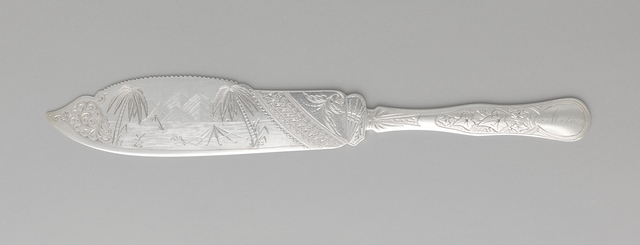Cakes and ice cream were the rage in the United States in the nineteenth century. People often entertained at tea and for dessert parties, so this meant the implements to serve these treats were often specialty items that did not match silver services for the dinner table. Some cake knives doubled as ice cream saws as their cutting edge could also saw through the brick-like consistency of ice cream kept cold with blocks of ice.
This example, sold by Albany silversmiths Sperry Douglas Brower and Son, after the retirement of Brower’s partner John Hewson in 1873, is engraved with the name Meta, for Meta Kemble deForest (1852-1933), who married Aesthetic Movement designer Lockwood deForest, in 1881. Lockwood deForest designed the teak library room in the Carnegie Mansion, now Cooper-Hewitt, National Design Museum. The carved woodwork in that room was made in a studio he set up in Ahmedabad, India, which he did while Meta and he were on a year-long honeymoon in India. The walls of the Teak Room are covered with Indian-inspired stencils of deForest’s design, all installed when the house was built in 1902.
What a woman Meta must have been! Our knowledge of the couple’s travels and collecting of Indian artifacts and designs, as well as some of the information about the establishment of deForest’s Ahmedabad wood and metalworking studio, is much due to letters Meta sent back to various family members. They saved many of these that now reside in the Smithsonian’s Archives of American Art. Meta was a good observer, supportive of her husband’s interests and clearly adventurous. While the couple often had introductions to well-connected people, they also stayed in places that were not for those who wanted luxury—but there were no complaints from Meta. I am not sure they ever camped in our sense of the word, but I like to think that she received this silver object from someone who knew she would appreciate the scene with the tent and palm trees.
Lockwood deForest was related to Frederic Edwin Church and travelled with him to the Middle East, where he sketched with Church, including in Egypt and Greece in the 1870’s prior to his marriage to Meta. He valued his sketches as souvenirs of pleasant places so it is tempting to associate the scene on the cake knife with one of the images he or Church created there. While we do not yet know who gave the cake saw to Meta, it is possible that the scene is taken from a sketch done by Lockwood deForest on his or their travels. However, it is tempting to link Frederic Church to the gift as the silver company that produced it was in Albany, much closer to Church’s exotic home Olana than to the deForests’ in New York City. This cake knife must have been engraved specially with the idea of giving pleasure to Meta and embodies the deForests’ interest in exoticism, which Meta shared with her husband, directly relating this piece of flatware for an amazing woman to the Teak Room here in the Museum. Maybe someday a wedding present register will surface in the family, or a letter from Meta to say thank you in someone else’s family, to tell us who the clever giver was!
<
p class=”rtecenter”>Today is National Knife Day
